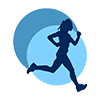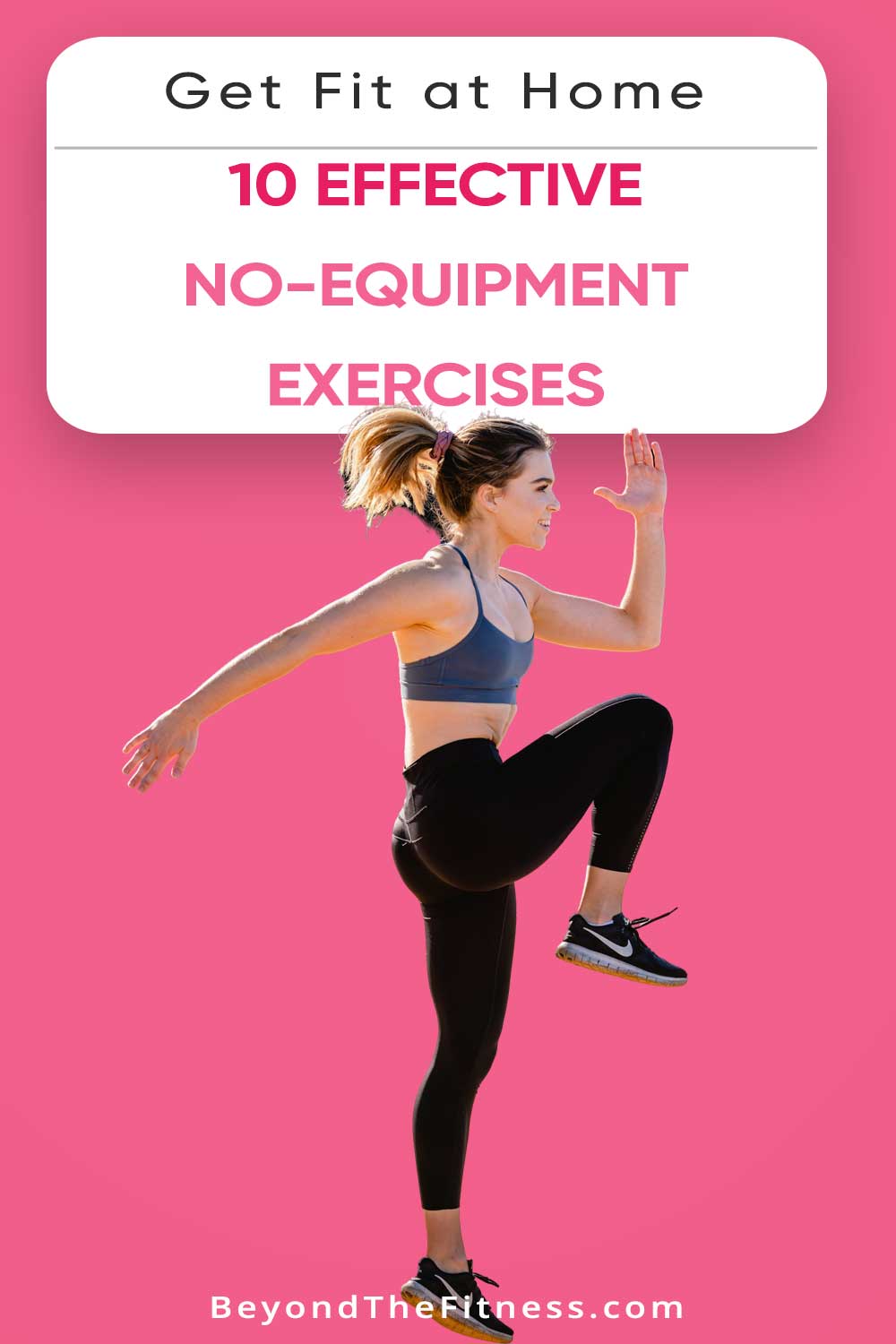Staying active doesn’t have to mean heading to a gym or buying fancy workout equipment. There are plenty of ways to get a great workout right in your living room or backyard using just your body weight. Here are my top ten no-equipment workouts that are simple, effective, and perfect for any fitness level.
1. Jumping Jacks
Jumping jacks are a fun way to get your heart rate up. They’re also super easy to do anywhere.
- How to do it: Stand tall with your feet together and hands by your sides. Jump your feet out wide while raising your arms overhead, then jump back to the starting position.
- Why it works: Jumping jacks help improve cardiovascular endurance, burn calories, and warm up your muscles.
- Tips: Go at your own pace. You can start slow and speed up as you get more comfortable.
2. Push-Ups
Push-ups are one of the best exercises for building upper body and core strength.
- How to do it: Begin in a plank position with your hands shoulder-width apart. Lower your chest toward the floor while keeping your back straight, then push back up to the starting position.
- Why it works: Push-ups strengthen your chest, shoulders, triceps, and core all at once.
- Tips: If regular push-ups feel too hard, try doing them on your knees or against a wall.
3. Squats
Squats are amazing for toning your legs and glutes.
- How to do it: Stand with your feet shoulder-width apart. Lower your hips down like you’re sitting in a chair, keeping your chest up and knees behind your toes. Push back up to stand.
- Why it works: Squats target your quads, hamstrings, and glutes while also improving your balance.
- Tips: Keep your movements slow and controlled to really feel the burn.
4. Plank
A plank is the ultimate core workout. It looks simple, but it’s challenging in the best way.
- How to do it: Get into a push-up position but rest on your forearms instead of your hands. Keep your body in a straight line from head to heels.
- Why it works: Planks strengthen your abs, back, shoulders, and even your legs.
- Tips: Start with 20 seconds and work your way up to longer holds as you get stronger.
5. High Knees
High knees are great for getting your heart pumping and working your lower body.
- How to do it: Stand tall and run in place while bringing your knees up to your chest. Swing your arms for extra momentum.
- Why it works: This move boosts your cardio endurance and works your legs and core.
- Tips: Try to land softly on the balls of your feet to avoid putting too much pressure on your knees.
6. Tricep Dips (Using a Sturdy Surface)
If you have a chair or low table, tricep dips are a fantastic way to work your arms.
- How to do it: Sit on the edge of the chair with your hands gripping the edge. Slide your hips off the chair and lower your body by bending your elbows, then push back up.
- Why it works: This move targets the back of your arms and helps tone them up.
- Tips: Keep your movements controlled and your back close to the chair for proper form.
7. Mountain Climbers
Mountain climbers are a full-body exercise that combines strength and cardio.
- How to do it: Start in a plank position. Bring one knee toward your chest, then quickly switch legs as if you’re running in place.
- Why it works: This move engages your core, shoulders, and legs while increasing your heart rate.
- Tips: Keep your back straight and your core tight throughout the exercise.
8. Lunges
Lunges are amazing for toning your legs and improving your balance.
- How to do it: Stand tall and step one foot forward, lowering your hips until both knees are bent at 90 degrees. Push back to the starting position and switch legs.
- Why it works: Lunges target your quads, hamstrings, glutes, and even your calves.
- Tips: Make sure your front knee doesn’t go past your toes to protect your joints.
9. Burpees
Burpees are a full-body workout that’ll leave you feeling strong and accomplished.
- How to do it: Start standing. Drop into a squat, place your hands on the floor, and jump your feet back into a plank position. Jump your feet back toward your hands, then leap into the air.
- Why it works: Burpees combine strength and cardio for a killer calorie-burning exercise.
- Tips: Go at your own pace and take breaks if needed—it’s okay to work up to this one!
10. Side Plank
The side plank is a great way to target your obliques and challenge your balance.
- How to do it: Lie on your side and prop yourself up on one forearm. Lift your hips off the ground so your body forms a straight line. Hold the position.
- Why it works: This move strengthens your core, especially the sides of your abs, and improves stability.
- Tips: To make it easier, lower your bottom knee to the ground for support.
These exercises are perfect for squeezing in a quick workout at home, whether you’ve got 10 minutes or 30. Just remember to listen to your body, stay hydrated, and have fun with it! You’ve got this!
How to Create a No-Equipment Workout Routine
It’s one thing to know the exercises, but how do you turn them into a complete workout? Don’t worry—I’ve got you covered. Here are some simple ways to build a routine using the exercises above.
Option 1: Circuit Training
Circuit training is a fun and fast-paced way to work out. You’ll move from one exercise to the next with little rest in between.
- How it works: Pick 5–6 exercises from the list. Perform each one for 30–45 seconds, then rest for 15–20 seconds. Once you’ve completed all the exercises, take a 1-minute break and repeat the circuit 3–4 times.
- Example circuit: Jumping jacks, squats, push-ups, high knees, planks, and lunges.
Option 2: EMOM (Every Minute on the Minute)
This is one of my favorite ways to stay motivated during a workout. EMOM keeps things simple yet challenging.
- How it works: Choose 2–3 exercises and decide how many reps of each you want to complete. Start a timer, and at the beginning of each minute, do the set reps for each exercise. Rest for the remainder of the minute before starting again.
- Example EMOM:
- 10 push-ups
- 15 squats
- 20 mountain climbers
Option 3: Tabata Training
Tabata is a high-intensity workout style that’s quick and effective.
- How it works: Perform one exercise for 20 seconds at maximum effort, then rest for 10 seconds. Repeat for 8 rounds (4 minutes total) before moving to the next exercise.
- Example Tabata: Try burpees for 4 minutes, then side planks for the next 4 minutes.
Tips for Staying Motivated with At-Home Workouts
Let’s face it—working out at home can sometimes feel less exciting than going to a gym or joining a class. Here’s how I keep things fresh and fun.
1. Set a Schedule
Pick specific days and times to work out and treat them like important appointments. This helps you stay consistent and build a habit.
2. Use Music to Pump You Up
Create a playlist of your favorite upbeat songs. I love how a good beat can energize me and make the time fly by.
3. Track Your Progress
Write down what you accomplish each day, like the number of reps or rounds you complete. Seeing your improvements over time will keep you motivated.
You Might Be Interested In: Learning more about The Complete Smoothie Detox & Weight Loss Program
4. Change It Up
Don’t be afraid to mix and match exercises or try different workout formats. Variety keeps things exciting and challenges your muscles in new ways.
5. Reward Yourself
Give yourself something to look forward to after completing your workout. Maybe it’s a delicious smoothie or some relaxing downtime.
Common Mistakes to Avoid
Even with simple exercises, it’s easy to make mistakes that can lead to frustration or even injury. Here are a few things to watch out for.
1. Skipping Warm-Ups
Jumping straight into your workout without warming up can put you at risk of injury. Spend 5–10 minutes doing light cardio or dynamic stretches to prepare your body.
2. Using Poor Form
Pay attention to your body position during each exercise. For example, during squats, keep your chest lifted and your knees behind your toes. If you’re unsure, try practicing in front of a mirror.
3. Doing Too Much Too Soon
It’s exciting to dive into a new fitness routine, but overdoing it can lead to burnout or soreness. Start with shorter workouts and gradually increase the intensity as you get stronger.
4. Forgetting to Breathe
Holding your breath while exercising can make you feel dizzy or tired faster. Remember to breathe deeply and steadily, especially during tougher moves like planks or push-ups.
How to Modify Exercises for Your Fitness Level
The beauty of bodyweight exercises is that they’re easy to adjust based on your fitness level.
Beginner Modifications
- Push-ups: Do them on your knees or against a wall.
- Squats: Lower down only halfway instead of going to a full squat.
- Planks: Rest your knees on the ground to make it easier to hold the position.
Advanced Modifications
- Push-ups: Try clap push-ups or add a pause at the bottom of the movement.
- Squats: Turn them into jump squats for an added cardio boost.
- Planks: Do a plank with shoulder taps or lift one leg for an extra challenge.
Why No-Equipment Workouts Are Perfect for Women
No-equipment workouts aren’t just convenient—they’re also great for building functional strength and improving overall fitness. Here’s why they work so well.
1. Boosts Muscle Endurance
Bodyweight exercises focus on endurance rather than maximum strength, which is perfect for daily activities like lifting groceries or playing with kids.
2. Builds Confidence
When you master exercises like push-ups or lunges, it feels empowering to know you’re getting stronger using just your body.
3. Improves Balance and Flexibility
Moves like lunges and planks help with balance and flexibility, which are essential for injury prevention and overall mobility.
4. Fits into a Busy Schedule
With no need for equipment or travel time, you can squeeze in a workout anytime, whether it’s during your lunch break or while the kids nap.
Stretching After Your Workout
Don’t skip the cool-down! Stretching helps your muscles recover and reduces stiffness. Here are a few simple stretches to try after your workout.
- Child’s Pose: Sit back on your heels with your arms stretched forward and forehead on the floor.
- Cat-Cow Stretch: Get on all fours and alternate between arching your back (cow) and rounding it (cat).
- Hamstring Stretch: Sit on the floor with one leg extended. Reach for your toes while keeping your back straight.
Hold each stretch for 20–30 seconds and focus on deep breathing to help your body relax.
How to Stay Safe While Working Out at Home
Safety should always come first, even when you’re exercising at home. Here’s how I stay injury-free.
1. Clear Your Space
Make sure there’s enough room to move around without bumping into furniture or other objects.
2. Wear the Right Shoes
Supportive sneakers can protect your feet and joints, especially during high-impact moves like jumping jacks or burpees.
3. Stay Hydrated
Keep a water bottle nearby and sip throughout your workout to stay hydrated.
4. Listen to Your Body
If something doesn’t feel right, stop and take a break. It’s better to modify or skip an exercise than risk injury.
These additional tips, routines, and safety measures will help you get the most out of your at-home workouts. The best part is, you don’t need fancy equipment or a gym membership—just a little space, some determination, and a positive attitude. Happy working out!







